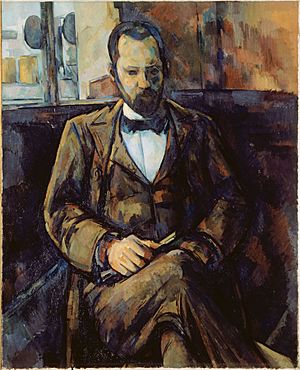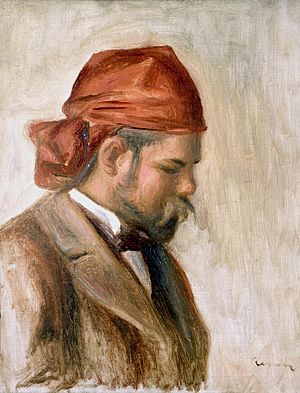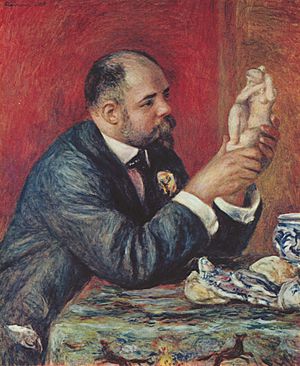Ambroise Vollard facts for kids
Quick facts for kids
Ambroise Vollard
|
|
|---|---|

Vollard, in front of Picasso's Evocación. El entierro de Casagemas
|
|
| Born | 3 July 1866 Saint-Denis, Réunion
|
| Died | 21 July 1939 (aged 73) Versailles, France
|
| Nationality | French |
| Occupation | Art dealer |
Ambroise Vollard (born July 3, 1866 – died July 21, 1939) was a French art dealer. He is known as one of the most important art dealers in France during the early 1900s. He helped many artists who were not famous yet. These artists included Paul Cézanne, Pierre-Auguste Renoir, Pablo Picasso, Paul Gauguin, and Vincent van Gogh.
Vollard also loved collecting art and publishing art prints.
Contents
Ambroise Vollard's Life
Ambroise Vollard was born in Saint-Denis, Réunion, which is a French island in the Indian Ocean. He grew up there. After finishing school, he moved to France in 1885 to study law. He earned his degree in 1888.
While studying, Vollard started working for an art dealer. In 1893, he opened his own art gallery in Paris. This street, Rue Laffitte, was a popular place for modern art at the time.
Vollard held his first big art shows there. He bought almost all the paintings by Paul Cézanne, about 150 of them, for an exhibition in 1895. He also showed works by famous artists like Manet, Paul Gauguin, and Vincent van Gogh. Later, he held the first exhibition for Pablo Picasso in 1901 and for Matisse in 1904.

Even though some people described him as a bit grumpy, Vollard was a very smart businessman. He became rich by buying art when it was less expensive and selling it for more. Many important art collectors were his clients.
In 1930, Vollard asked Pablo Picasso to create a series of 100 etchings. These became known as the Vollard Suite. He had also asked Paul Gauguin to make a smaller series of woodcuts earlier, but Vollard did not like them as much.
Vollard also wrote books about artists like Paul Cézanne, Degas, and Pierre-Auguste Renoir. In 1937, he wrote his own life story called Recollections of a Picture Dealer.
Vollard as a Publisher of Prints
Vollard opened his gallery in Paris in 1890. He showed art by many important artists like Paul Gauguin, Henri Matisse, Paul Cézanne, and Pierre-Auguste Renoir. In 1901, he held the first show for Pablo Picasso.
Vollard especially liked to help artists whose work was not accepted by the official art shows. He made enough money from selling paintings to pay for printing art. He was very careful about the quality of his prints. He always wanted the best materials and the best people to help him.
Most of Vollard's prints were special limited editions for collectors. He often asked artists directly to create new prints for him. For example, his first art album was by Pierre Bonnard in 1895. He published 100 copies, and the artist signed each one.
He also published books with art illustrations for people who loved books. He worked on 22 such projects between 1900 and 1939. Vollard usually chose the artist, and sometimes the artist chose the story to illustrate. Some famous books he published include Parallèlement by Paul Verlaine, illustrated by Pierre Bonnard, and Imitation of Christ, illustrated by Maurice Denis.
During World War I, it was hard to find good materials. So, Vollard sometimes used photoengraving for his prints. He still made high-quality works, especially with the help of artist Georges Rouault.
One of Vollard's most famous projects was with Pablo Picasso. This led to the well-known Vollard Suite of prints. Picasso created 100 prints for Vollard between 1930 and 1937. These prints showed different themes, like a sculptor and his model. They also included three portraits of Vollard himself.

Picasso also made other important prints for Vollard. For example, Minotauromachy in 1935, which showed a Minotaur (a creature from Greek myths). He also illustrated Historia natural by Buffon (published in 1942). In 1937, Picasso made The Dream and Lie of Franco as a protest against the Spanish Civil War.
Portraits of Vollard
Many artists painted portraits of Ambroise Vollard. This shows how important he was to them and how much he helped their careers.

The first famous portrait was Portrait of Ambroise Vollard by Paul Cézanne in 1899. Other well-known portraits include:
- Portrait of Ambroise Vollard in a Red Headscarf by Pierre-Auguste Renoir (1899)
- Portrait of Ambroise Vollard with a Cat by Pierre Bonnard (around 1924)
- Portrait of Ambroise Vollard by Pablo Picasso (1910)
Picasso once said that all these artists painted Vollard because they wanted to show they could do it better than the others.
Vollard's Death
In July 1939, as war was getting closer, Vollard was traveling from his country home to his mansion in Paris. He had stored 10,000 artworks there. His car skidded on a wet road and crashed. He died at the age of 73.
Vollard's Art Collection
After Vollard died, his art collection was supposed to be divided between his family. However, World War II started. A dealer named Martin Fabiani quickly sent 560 paintings to the United States.
The ship carrying the paintings was stopped by the British Navy. The paintings were seen as "enemy property" and stored in Canada during the war. After the war, in 1949, a court allowed the paintings to be returned to Vollard's family. As a thank you, the family gave some prints by Georges Rouault and Marc Chagall, and one painting by Paul Gauguin, to the National Gallery of Canada. The rest of the art was quickly sold in New York City.

Vollard also had a young assistant named Erich Šlomović. Šlomović had collected about 600 artworks, mostly prints and drawings, with some important oil paintings. He wanted to create a museum of French art in his home country, Yugoslavia.
In 1940, Šlomović put about 200 artworks in a bank vault in Paris. He took about 450 works home and showed them in Croatia. When the German army advanced, he and his family went into hiding. They hid the paintings behind a wall in a farmhouse. Sadly, Šlomović and his family were killed during the war.
After the war, the paintings in Yugoslavia were taken by the government. They were shown only once in 1989. There is still a legal discussion about who owns these paintings today.
The artworks hidden in the Paris bank were found in 1979. After a long legal battle, a court decided in 1996 that these paintings belonged to Vollard's family. They were sold at auction in 2010 for a lot of money. These included works by André Derain, Mary Cassatt, Paul Cézanne, Marc Chagall, Degas, Pablo Picasso, and Pierre-Auguste Renoir.
See also
 In Spanish: Ambroise Vollard para niños
In Spanish: Ambroise Vollard para niños

